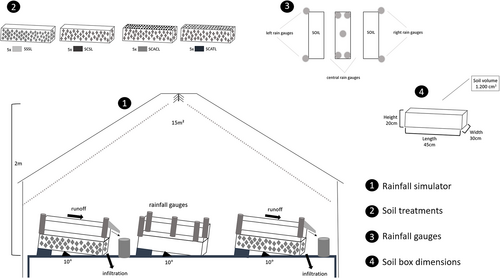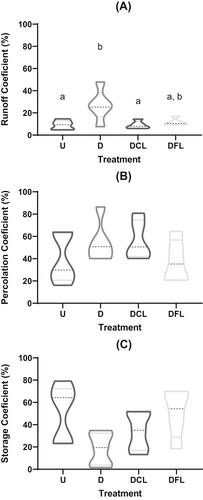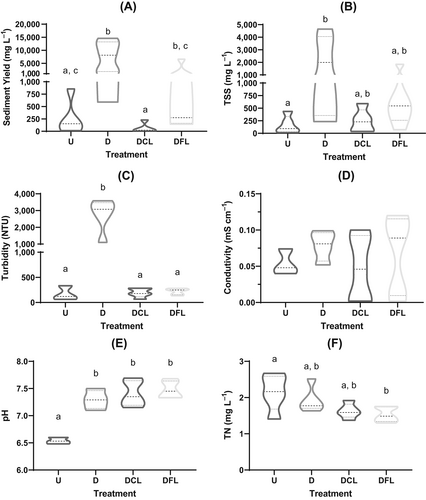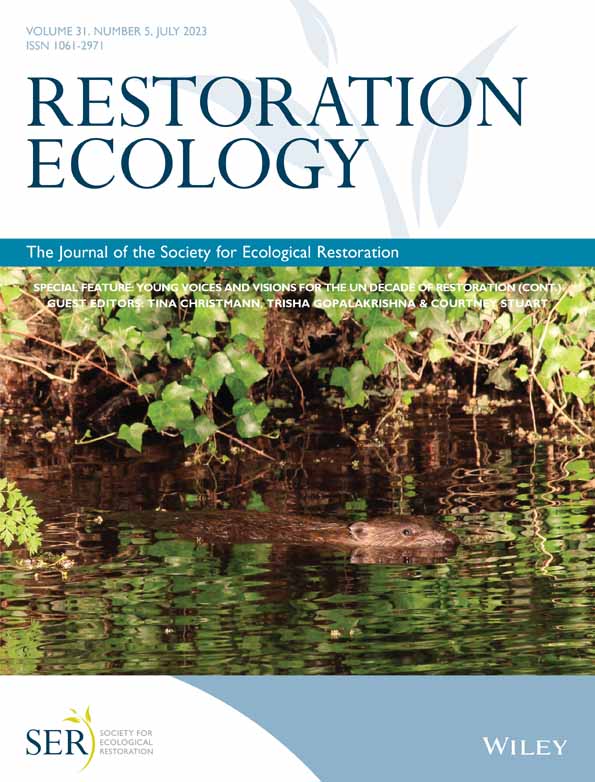Litter addition as a tool for restoring hydrological processes and controlling erosion in riparian forests disturbed by fine sediment deposition
Author contributions: RWF, ATCD conceived and designed the research; RWF, MPFS performed the experiments; RWF, MSB analyzed the data; ATCD, RLB, MPFB contributed reagents/materials/analysis tools; all authors wrote and edited the manuscript.
Abstract
Riverscape aggradation due to the deposition of fine particles above natural forest litter can change the soil, sediment, and water properties, damage riparian vegetation, and reduce environmental integrity, especially in headwater streams. Litter addition techniques that enhance surface roughness and permeability can decrease the interference of fine particles on the ecosystem, representing a low-tech alternative to recover disturbed riparian areas. We aimed to evaluate run-off, percolation, storage coefficients, run-off volume, and sediment yield using a rainfall simulator and the mitigation potential provided by the addition of forest litter to limnological variables—turbidity, total suspended solids (TSS), electrical conductivity, pH, nitrogen—which are indicators of integrity that can reflect streams' aggradation. Fifteen soil samples from a disturbed area (silt and clay deposits aboveground), five from an undisturbed area (sandy soil), and superficial forest litter were obtained from riparian areas adjacent to two small streams in Carajás National Forest, Brazil. The addition of litter showed great potential to mitigate erosive processes and to reestablish hydrological processes in the disturbed soil. The run-off volume and sediment yield were 2–4 times lower in litter addition treatments compared to non-litter addition. Litter addition also improved run-off water quality, especially turbidity and TSS, which were 12–16 times and 3–13 times lower, respectively. The experimental addition of litter has shown encouraging results to be applied in situ as a sustainable, low-cost, and simplified nature-based solution to contribute to the restoration of degraded riparian forests and reduce in-stream silt and clay aggradation.
Implications for Practice
- Given the scale of fine sediment accumulation induced by human activities, there is a need to develop techniques easy to apply on soil restoration to mitigate run-off on small streams.
- We recommend litter addition in riparian areas disturbed by silt and clay deposition due to its effect in decreasing water's turbidity and suspended solids which contributes to maintain streams resilience and, therefore, save biodiversity.
- We also recommend increasing the focus on local, low-cost and low-tech methods for soil restoration. These are key characteristics on developing countries.
- The study demonstrates that limnological attributes used to evaluate aquatic integrity comes from the interaction between water quality and soil conservation which highlight the importance of riparian protection zones as critical for riverscape health.
Introduction
Hillslope erosion and delivery to stream channels is a natural process, but rates can be increased by anthropogenic activities. (Hooke 2000). Although mining activities causes a relatively small loss of vegetation as compared to other land use changes (Geist & Lambin 2002), some mining activities, as for example, mountain-top removal mining does cause loss of substantial vegetation area (Palmer et al. 2010), plus its off-site environmental impacts due to the inappropriate managements of tailings, erosion, and run-off can generate impacts far outside the immediate mine footprint. This is particularly important for nearby aquatic ecosystem, which often show increased turbidity and aggradation downstream of mining areas (Wantzen & Mol 2013). Also, besides the nearby rivers, fine sediment that accumulates in rivers and floodplains after tailing dam failures can harm downstream water quality even after the initial dam collapse. In the last decade, two major disasters involving the collapse of tailing dams in Brazil unleashed a large volume of fine sediments to Doce and Paraopeba rivers and their floodplains causing ecosystem degradation (Carmo et al. 2017; Cornwall 2020). Besides the loss of human lives, culture, and biodiversity, an immense challenge remained for environmental managers to repair both rivers. In addition to large-scale environmental catastrophes, other accidents due to mining involving disruption of dams and sterile soil piles can also impact aquatic ecosystems on a smaller scale (Cornwall 2020). Such events can affect the riverscape of large rivers and headwater streams as mining exploitation takes place throughout the watersheds, and the effects can leave a high volume of fine sediments on the streambed, banks, and riparian area. Therefore, it is of great importance to develop management practices to reduce the mobilization of fine sediments in aquatic ecosystems.
Restoration practices that enhance surface roughness, promote infiltration as opposed to surface run-off, and enhance soil cohesion would help reduce fine sediment run-off. Examples of such activities include use of natural roughness features such as leaves, branches and rocks. They also represent low-tech and small cost alternatives for soil cover along with riparian forests restoration programs that could be broadly applied on riverscapes.
The presence of riparian vegetation adjacent to small streams can reduce erosion by stabilizing soil, increasing infiltration, and reducing run-off (Liu et al. 2018; Krzeminska et al. 2019; Li et al. 2019). Forest litter layers prevent soil sealing, increase water residence time, and reduce the kinetic energy of raindrops, acting as an important interface between the soil and the atmosphere (Walsh & Voigt 1977; Geddes & Dunkerley 1999; Makarieva et al. 2014). The importance of the presence and the amount of litter for hydrological processes is well established (Walsh & Voigt 1977). More recently, studies showed that species with contrasting leaf traits can form litter layers with different properties and consequences to hydrological and erosive processes (Sato et al. 2004; Dias et al. 2017). Sato et al. (2004) showed that broad leaf litter has a higher storage capacity as compared to needle leaf litter, indicating that species composition can modulate soil water fluxes. This opens the question on whether it is possible to select litter with specific traits as size and shape to reduce run-off and consequent erosion on impacted areas, therefore selecting species for restoration with functional targets (Laughlin 2014).
When large loads of run-off fine particles deposit above litter layers on riparian areas they can bury the litter layer and damage vegetation, which, in turn, reduces new litter input to the soil (Li & Stella 2016). Some studies have previously shown that the litter addition on disturbed soils can reduce run-off and provide nutrients for plants and soil organisms (Dias et al. 2012; Gu et al. 2020), other studies considered the positive effects of litter accumulation on riparian vegetation regrowth measured as soil respiration and nitrogen cycling functions (Xiong et al. 2001; O'Brien et al. 2017). However, impacts of fine sediment accumulation, such as seen during tailing dam failures, are increasingly being addressed through restoration worldwide. Even with the increasing number of experiments on those ecosystems, just a few consider active litter addition as a restoration practice (Roni & Beechie 2012; Kollmann et al. 2016). Although canopy and litter presence on soil are known as crucial factors to mitigate erosion and run-off, the relationship between the presence of litter in riparian areas disturbed by silt and clay deposition, and its effects on limnological variables that guide streams assessment and restoration programs are poorly understood (Brown et al. 2018).
The aim of this study was to experimentally evaluate the effects of adding coarse and fine litter on run-off reduction and on limnological variables in streams affected by mining activities in the Amazon Forest. The limnological variables (run-off water, pH, electrical conductivity, turbidity, total suspended solids, and total nitrogen) are used to evaluate environmental integrity changes in streams due to the run-off of fine sediments.
It is expected that litter addition on impacted soils reduces run-off water, erosion, turbidity, and total suspended soils and increases water infiltration into soils. Also, is expected fine litter addition on impacted soils improves the quality of run-off water compared to absence of litter or even the coarse litter, due to the high density of fine litter fragments, high water storage, and flow blocking capacity, which can reduce the kinetic energy of the drained water and number of small inorganic particles suspended and transported on the water.
Methods
Experimental Design
To evaluate whether the addition of leaf litter to soils disturbed by fine sediment accumulation can reduce run-off, we performed a laboratory experiment, in which soils collected from disturbed sites were amended with litter and subjected to simulated rainfall. The soils were arranged evenly in 20 boxes (soil samples) and we divided the experiment into 4 treatments (U = undisturbed soil or control; D = disturbed soil with few grasses which are naturally growing on disturbed site; DCL = disturbed soil like D with addition of coarse litter; DFL = disturbed soil like D with addition of fine litter) with 5 replicates from each group (Table S1) that allowed collection of run-off and percolated water during simulated rainfall. For this study samples were collected from two different riparian areas in Carajás National Forest in Pará State, Brazil. Five samples from a preserved riparian forest adjacent to Águas Claras stream (east: 572321; north: 9320586—UTM Sirgas 2000 22S) and 15 samples from a riparian forest disturbed by aggradation of fine particles adjacent to Kalunga stream (east: 574704; north: 9325319—UTM Sirgas 2000 22S). Both streams are third-order streams, situated in an Amazonian Mountain area at 450 m a.m.s.l., which averages 300 mm monthly during the rainy season and the sites where the soil samples were collected are about 5 km distant from each other (MMA & ICMBio 2016).
It is important to highlight the difference between disturbed and undisturbed soil grain size. This difference occurs due to the strong silting on the channel and the marginal areas in the area impacted by fine soil from an accident with a pile of waste mining material.
This experiment was conducted in March 2019 at the Native Plant Nursery Laboratory and was carried out in the laboratory to allow us to control and standardize rainfall conditions, slope, and litter size to test the effect of rainfall simulation on run-off above two types of soil covered by two types of litter size placed on experimental boxes.
Soil and Litter Samples
We collected soils samples of 0–30 cm depth. At each site, samples were taken at least 10 m away from each other. The samples were obtained using a rectangular, metallic, and stable soil sampler (20 × 28 × 42 cm) developed by our research group to help us take soil samples from the field reducing changes to the original vertical profile features of the topsoil. The bottom of the samples was trimmed and they were immediately transferred to hard plastic boxes (20 × 30 × 44 cm) with minimal pressure to preserve the natural soil structure. Also, three soil replicates were sampled by a cylindrical corer collector (h = 30 cm; area = 50 cm2) to determine grain size. We collected samples from the surface litter (0–5 cm) using an agronomic rake and stored it in plastic bags. At the laboratory, we spread the litter samples for air drying for 3 days and divided them into two major groups considering their size. Leaf litter fragments smaller than 5 cm in length were placed in the fine group, while fragments bigger than 5 cm were placed in the coarse group. The fine and coarse litter were added systematically to cover all exposed soil surface in the boxes. We selected litter with few marks of decomposition.
Rainfall Simulation
There is huge variability in rain events in tropical forests. In our experiment, we simulated a high-intensity rain event which we believe can generate strong effects on the soil to measure hydrological and erosive responses.
Rain was simulated using a spray nozzle (Spraying Systems FULLJET GG-30 W) placed at 2 m above the sample. At this position, the simulated rain delivered drops of about 3 mm, spraying a full cone shape of 15 m2 (Tossell et al. 1987, 1990). During each experimental round, the simulated rainfall ran for 15 min with an average precipitation intensity of 103 mm h−1 (±9.5 mm h−1; Fig. 1). We used nine rainfall gauges to record precipitation during the experiment.

Below each soil treatment box, we placed a plate on the back side to increase the slope, and we set the slope to 10° using a digital 9-axis Gyroscope Accelerometer. We used an aluminum gutter to direct run-off samples to drop in glass bottles for later limnological analysis (Fig. 1). The boxes with the soil treatments contained small holes at the bottom to drain excess percolation and directed the infiltrated material to plastic trays placed below to retain the percolated material samples for volume analysis (Fig. 1).
We measured run-off and percolation total volumes using glass beakers and estimated storage volume. The run-off and percolated solutions were sampled 15 min after the last observed drop of water from the run-off collector from the rainfall. We also calculated run-off, percolation, and storage coefficients as percentages from the ratio between run-off and rainfall; percolation and rainfall; storage water by soil/litter and rainfall.
From run-off water, the pH, electrical conductivity, and turbidity were measured by a portable multiparameter sensor Horiba U-52G. Total nitrogen (TN) was analyzed by digestion of the sample following the subsequent quantification performed by the TOC-V CPH/TOC-V CPN Shimadzu equipment (Valderrama 1981). To determine TSS, the run-off solution was filtered on Whattman GF/F 0.7-μm filters, previously weighted, and dried in an oven; then, the gravimetric difference was performed with the filter mass before and after drying to obtain the suspended solids values (Standard Methods Committee of the American Public Health Association, American Water Works Association, and Water Environment Federation 2017).
Statistical Analysis
To verify the relationship among variables and reduce variables on posterior ordination analysis, we performed Spearman rank correlations (p ≤ 0.05) and eliminated variables that were strongly correlated (Bonett & Wright 2000). To visualize overall differences among treatments and perform an ordination of the response variables, we applied a principal component analysis (PCA; Lever et al. 2017). Also, we used one-way analysis of variance (ANOVAs; p ≤ 0.05) to test differences among the treatments for limnological variables (Scheiner 2020).
We considered two selection criteria as the main PCA vectors: auto value >1, and the broken stick model. For one-way ANOVA data were log-transformed, and significant differences were followed by a Tukey's multiple comparisons test (p ≤ 0.05) to determine the differences between each treatment.
Results
The three groups composed by the variables: (i) TSS, turbidity, and sediment yield; (ii) run-off coefficient and run-off volume; (iii) percolation coefficient and storage coefficient, showed a high correlation between the variables that comprised them. Only the percolation coefficient revealed a negative correlation to the storage coefficient. The other groups and variables were positively correlated (Table S2).
The first two axes of the PCA, after excluding high correlated variables, accounted for 65% of the total data variability. We observed a strong separation in two groups, the run-off coefficient along the first component axis, where most of D treatment replicates segregated from the others (Fig. 2). The second component axis was represented by pH and TN (Fig. 2).

The D treatment showed a run-off coefficient from 2.5 to 3 times greater than the other treatments (Fig. 3). We detected significant differences in the run-off coefficient between D and U and between D and DCL treatments (run-off coefficient: F = 5.11; p ≤ 0.05; Fig. 3). The grain size distribution of the undisturbed soil was much different than the grain size distribution of the disturbed soil, 95% of the U treatment soil was composed by sand and more than 80% of the D, DCL, and DFL treatments were composed by silt and clay (Table S1).

We found significant differences among the treatments for all limnological variables, except for water's electrical conductivity (Fig. 4). Sediment yield, TSS, and turbidity were the variables that best responded to the influence of soil types and litter cover (Fig. 4). The D treatment revealed the highest values for sediment yield and its respective high correlated variables (TSS and turbidity; Figs. 3 & 4). The average sediment yield from the D treatment was 4 to 120 times higher than the other treatments, and D differed significantly from U and DCL (F = 10.71; p ≤ 0.05). Regarding the TSS averages, the D treatment showed values from 3 to 13 times higher than the other treatments, but only differing significantly compared to the U treatment (F = 4.29; p ≤ 0.05). The average turbidity from the D treatment differed significantly from the others (F = 29.78; p ≤ 0.05) and showed values from 12 to 16 times higher than the other treatments. Regarding the pH, the results were divided between the type of soil. Sandy soil showed lower pH, and the silt and clay soils showed higher pH (F = 22.68; p ≤ 0.05; Fig. 4). However, these groups differed by about 0.8–1.0 in the pH value. Concerning TN, we found a significant difference (F = 3.49; p ≤ 0.05) between U and DFL treatments (Fig. 4).

Discussion
The addition of forest litter was an important mitigator of erosive processes and run-off of fine particles in our experiment with soil found on the riparian area of a stream reach disturbed by heavy silt and clay aggradation. Thus, forest litter contributed to reestablishing hydrological processes in the disturbed soil, such as occurs in the undisturbed area. The added litter significantly reduced the degradation of the water quality from run-off material, especially sediment yield, TSS, and turbidity, as it protected the water from suspension and transportation of fine particles.
The high values for run-off coefficient, TSS, and their respective correlated variables in the D treatment showed the potential of rain to erode and transport fine soil fragments, especially in poorly protected soils (Tabacchi et al. 2000). We believe that with the absence of the added litter, the raindrop impact on soil easily broke soil aggregates and crumbled silt and clay particles that remained mobile and suspended in solution in the surface water flow generated in the experimental slope since this flow encountered little physical resistance when transporting material. Therefore, in the present study, the addition of litter, mainly the coarse fragments showed a great potential in reducing the run-off by mitigating the splash erosion, and the subsequent decrease on carrying particles, which in a real case scenario, it could be the stream.
Our results corroborate other studies that have already shown the mitigating effect of erosion provided by litter addition (Sato et al. 2004; Mohammad & Mohammad 2010; Li et al. 2013; Li et al. 2014). Plus, it demonstrates a very efficient process-based restoration tool about hydrological and erosive processes, and this can significantly reduce the impacts on the quality of the drained water that eventually will be transported to the streams.
Apart from the D treatment, contrary to what we expected considering the high density of fine litter fragments, high water storage, and flow blocking capacity which can reduce the kinetic energy of the drained water, we found higher sediment yield and TSS concentration in the DFL treatment than the others. We believe that due to the high rainfall intensity and reduced mass of the small litter fragments in DFL, they detached easier from soil and were carried away by run-off. In our experiment, despite DFL having carried suspended material, it can be even beneficial for fluvial ecosystems as an entry of organic matter as occurs during rainfall events in forest soils, since this process corresponds to a vital source of energy for small streams covered by closed-canopy (Allan & Castillo 2007). However, the leaching of plant detritus, easily transported by the run-off, would reduce the effectiveness of adding litter as a nature-based solution that expects to receive few interventions for maintenance for the application in long term (Jorgensen 2009).
High values of turbidity and TSS are usually associated with excess sedimentation of fine particles in lotic ecosystems (Hannouche et al. 2011; Oliveira et al. 2018). Its effects can be very detrimental to biodiversity, especially in low-order streams. This process speeds up physical abrasion and adsorption on organic matter in areas with higher flow rates and covers plant detritus in deposition areas, making them unavailable to biological communities (Doretto et al. 2016; Martínez et al. 2020). In addition, fine sediments fill physical space and reduce the availability of habitats in the streambed for organisms (Mathers et al. 2017). The direct effects are generally related to the reduction of physiological functions and organisms drift from areas with a greater suspension of solids (Henley et al. 2000; Suren & Jowett 2001). The indirect effects are associated with reduced growth, reproduction, recruitment rates, food availability for biological communities, and even mortality (Henley et al. 2000; Downing et al. 2012).
Apart from protecting water integrity, a diversified litter still offers several functions for terrestrial biodiversity as microclimate, diversification of habitats, and plant establishment (Dias et al. 2017). We believe in the potential of litter addition as a technique that can bring direct beneficial effects for local biodiversity and in this study as an experimental case to show its challenges and results to be applied in other areas worldwide (Owens et al. 2005; Wohl et al. 2015).
While the natural regeneration litter found on disturbed soil and not covered by litter addition (D treatment results) has shown lower potential for controlling run-off, the addition of litter (DFL and DCL), especially of larger fragments (DCL), reduced the run-off and proved to be effective in mitigating the environmental impacts of solids suspension, turbidity, and sediment yield on the water caused by rain drained from silt and clay soils. These impacts may reduce water quality and generate harmful effects on biodiversity in aquatic ecosystems. Therefore, the experimental addition of litter on soil has shown encouraging results to be applied on field conditions as a low-cost, and low-tech nature-based solution to contribute to the restoration of riparian forests disturbed by deposition of fine particles, but field-scale trials would be needed to determine whether the erosion prevention benefits of the litter addition scale up to whole-riparian zones at which restoration would be applied.
ACKNOWLEDGMENTS
The authors thank VALE SA for funding, laboratory, and staff, especially Leandro Maioli, Luiz Batista, Jenaldo Carvalho, Jefferson Souza, and Delmo Silva. The authors thank the UFRJ Limnology Lab team, specially João Marcelo Souza, Mariana Andrade, Kayza Freitas, Bianca Afonso, Fabricio Gonçalves, Mariana Angelo, Maria Cosendey and Isabella Mendanha for their effort along the experiment and text reviewing. The authors also thank Pedro Rajão for sharing his expertise on rainfall simulation. The authors thank CAPES, PPGCIAC Post-graduation program, and NUPEM-UFRJ for funding, laboratory, and technical support. The authors thank ICMBio and IBAMA for the research license and logistics. This work was carried out under the Limnological Studies Program of Carajás National Forest, which has part of its activities aimed at mitigating the impacts of mining activity on biodiversity.




